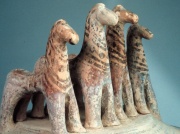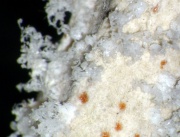Difference between revisions of "Efflorescence"
m (Text replace - "== Authority ==" to "== Sources Checked for Data in Record ==") |
|||
| (6 intermediate revisions by the same user not shown) | |||
| Line 1: | Line 1: | ||
[[File:Efflouresc3.jpg|thumb|Efflorescence]] | [[File:Efflouresc3.jpg|thumb|Efflorescence]] | ||
== Description == | == Description == | ||
| − | + | [[File:Efflorescence.40x.jpg|thumb|Efflorescence at 40x]] | |
A white powdery crust formed by extraneous salts evolving on the surface of an object (typically stone, plaster, or ceramics) as a result of water migration and subsequent evaporation. Typical efflorescence on masonry surfaces occurs when moisture dissolves water soluble salts, then seeps to the surface, where the water evaporates leaving a salt residue. Efflorescence crystal growth can result from fluctuations in water vapor pressure that occur with changing humidity and temperature. The salts most commonly found in efflorescence are sulfates, carbonates, and chlorides of [[sodium]], [[potassium]], [[magnesium]], [[calcium]], and [[iron]]. Efflorescence is associated with several degradative mechanisms such as salt petering, [[exfoliation]], [[flaking]], and [[spall|spalling]]. [[Deliquescence]] is the converse phenomenon. | A white powdery crust formed by extraneous salts evolving on the surface of an object (typically stone, plaster, or ceramics) as a result of water migration and subsequent evaporation. Typical efflorescence on masonry surfaces occurs when moisture dissolves water soluble salts, then seeps to the surface, where the water evaporates leaving a salt residue. Efflorescence crystal growth can result from fluctuations in water vapor pressure that occur with changing humidity and temperature. The salts most commonly found in efflorescence are sulfates, carbonates, and chlorides of [[sodium]], [[potassium]], [[magnesium]], [[calcium]], and [[iron]]. Efflorescence is associated with several degradative mechanisms such as salt petering, [[exfoliation]], [[flaking]], and [[spall|spalling]]. [[Deliquescence]] is the converse phenomenon. | ||
| − | |||
| − | |||
== Synonyms and Related Terms == | == Synonyms and Related Terms == | ||
encrustation; bloom | encrustation; bloom | ||
| − | |||
| − | |||
| − | |||
| − | |||
== Additional Images == | == Additional Images == | ||
<gallery> | <gallery> | ||
| − | File:Efflorescence.16x.jpg|Efflorescence | + | File:Efflorescence.16x.jpg|Efflorescence at 8X of Aluminum potassium sulfate crystals |
| − | File:Efflourescence-01_ICOMOS.jpg| | + | File:Efflourescence-01_ICOMOS.jpg|Efflorescence on dolomitic limestone<br>Credit E. Doehne |
| − | File:Efflourescence-02_ICOMOS.jpg| | + | File:Efflourescence-02_ICOMOS.jpg|Efflorescence on sandstone<br>Credit: E. Hyslop |
| − | File:Efflourescence-03_ICOMOS.jpg| | + | File:Efflourescence-03_ICOMOS.jpg|Efflorescence on limestone<br>Credit: V. Vergès-Belmin |
</gallery> | </gallery> | ||
| + | == Resources and Citations == | ||
| + | * ICOMOS-ISCS: [http://www.international.icomos.org/publications/monuments_and_sites/15/pdf/Monuments_and_Sites_15_ISCS_Glossary_Stone.pdf Illustrated glossary on stone deterioration patterns] | ||
| − | + | * E. Ordonez and J. Twilley, "Clarifying the Haze" Analytical Chemistry, 69,:416 (1997). | |
* Random House, ''Webster's Encyclopedic Unabridged Dictionary of the English Language'', Grammercy Book, New York, 1997 | * Random House, ''Webster's Encyclopedic Unabridged Dictionary of the English Language'', Grammercy Book, New York, 1997 | ||
Latest revision as of 13:17, 1 August 2022
Description
A white powdery crust formed by extraneous salts evolving on the surface of an object (typically stone, plaster, or ceramics) as a result of water migration and subsequent evaporation. Typical efflorescence on masonry surfaces occurs when moisture dissolves water soluble salts, then seeps to the surface, where the water evaporates leaving a salt residue. Efflorescence crystal growth can result from fluctuations in water vapor pressure that occur with changing humidity and temperature. The salts most commonly found in efflorescence are sulfates, carbonates, and chlorides of Sodium, Potassium, Magnesium, Calcium, and Iron. Efflorescence is associated with several degradative mechanisms such as salt petering, Exfoliation, Flaking, and spalling. Deliquescence is the converse phenomenon.
Synonyms and Related Terms
encrustation; bloom
Additional Images
Resources and Citations
- ICOMOS-ISCS: Illustrated glossary on stone deterioration patterns
- E. Ordonez and J. Twilley, "Clarifying the Haze" Analytical Chemistry, 69,:416 (1997).
- Random House, Webster's Encyclopedic Unabridged Dictionary of the English Language, Grammercy Book, New York, 1997
- The American Heritage Dictionary or Encarta, via Microsoft Bookshelf 98, Microsoft Corp., 1998
- R. J. Gettens, G.L. Stout, Painting Materials, A Short Encyclopaedia, Dover Publications, New York, 1966
- Ralph Mayer, A Dictionary of Art Terms and Techniques, Harper and Row Publishers, New York, 1969 (also 1945 printing)
- Dictionary of Building Preservation, Ward Bucher, ed., John Wiley & Sons, Inc., New York City, 1996
- Anne Grimmer, Glossary of Building Stone Terms, A Glossary of Historic Masonry Deterioration Problems and Preservation Treatments, National Park Service, Washington DC, 1984
- Caring for your Collections, Arthur W Schulz (ed.), Harry N. Abrams, Inc. , New York, 1992


